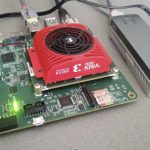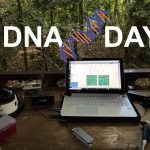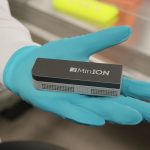Tag Archives: nanopore
Open CycloneSeq Benchmarking For Complete Bacterial Genomes
Scott Edmunds - April 25, 2025

As another DNA Day treat GigaByte today publishes new benchmark data and analysis of the new CycloneSEQ platform, a novel sequencing technology using nanopores that demonstrates here the ability to sequence complete bacterial genomes. Following on from the recent official launch of BGI’s new CycloneSEQ single-molecule sequencer the new Data Release published today in GigaByte […]
Selective sequencing on a shoestring: the $300 HARU system
Hans Zauner - July 4, 2023

This week GigaScience published a cost-effective, open source hardware/software solution for selective sequencing, using the Nanopore Minion device and a tiny $300 device that is “two times faster than a 30,000 $ 36-core server, at a fraction of power consumption”.
iPhone Genomics: beaming us up to the “tricorder” era
Scott Edmunds - December 8, 2020

The 1st comprehensive mobile genome analysis application, iGenomics, is now available for use on an iphone. By pairing an smartphone with a handheld DNA sequencer, users will be able to create a mobile genetics laboratory, reminiscent of the Star Trek’s tricorder.
Mock the Metagenome. Author Q&A with Nick Loman & Sam Nicholls
Scott Edmunds - May 15, 2019

The mock metagenome, MAGs and breaking the first rule of Long Read Club Out today in GigaScience is a new “mock metagenome” Data Note from the Nick Loman lab in Birmingham showcasing the latest long-read sequencing technologies from Oxford Nanopore. Having published the first nanopore E. coli genome with us in 2014 showcasing the then […]
DNA Day in the Jungle. Aaron Pomerantz on #JungleOmics
Scott Edmunds - April 25, 2018

I’m a genomicist, get me into here. Today is DNA Day, commemorating the day in 1953 when Watson, Crick, Wilkins, Franklin et al. published their Nature papers on the structure of DNA, as well as the day in 2003 that the completion of the Human Genome Project was declared. Or at least when the project […]
A firsthand perspective of trialling mobile DNA sequencing
Andy Kilianski and Sam Minot - March 27, 2015

Sam Minot from Signature Science, LLC and Andy Kilianski from the Edgewood Chemical Biological Center are part of a team that has been trialling a new palm-sized DNA sequencer to test whether it can characterize viruses and bacteria. Their findings, published in GigaScience suggest the device could have potential for disease diagnosis in the field.